This is the second part in my story of installing a solar photovoltaic system in the Northern California Bay Area.? You can also read Part 1, Solar Panels / Energy.
I figure the best way to organize what happened is to do a timeline from the very beginning:
4/1/2010: Contract with REC Solar signed. The process is:
- REC does a site evaluation
- REC pulls permits
- I go with REC to Costco to purchase modules & inverter
- Roof Right removes old roof and installs plywood and underlayment
- REC installs the roof mounts for the rails
- Roof Right installs the rest of the roof
- REC installs modules, inverter, and all electrical
- REC coordinates city inspection
- REC submits all the info to PG&E
- PG&E does interconnection
- I turn the system on!
The whole process is expected to take 14 weeks which includes the 3 weeks for the PG&E interconnection.? So, that would be a completion date of mid July.
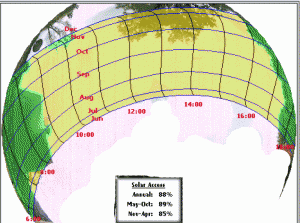 4/13/2010: REC sends out their crew to do a site evaluation.? This includes getting the roof measurements (dimensions, pitch, direction etc.) and the shade analysis.
4/13/2010: REC sends out their crew to do a site evaluation.? This includes getting the roof measurements (dimensions, pitch, direction etc.) and the shade analysis.
They have a cool device that takes a “fishbowl” image of the sky from various points on the roof to show what items will cast a shadow onto the roof (click the image to the right).? We discover that the chimney and two big oak trees will be casting significant shadows onto the roof. ? Not much we can do about the chimney other than shift around the modules a little.? The trees will either need to come out or be significantly “topped”.
Note:? In the shade image the engineers highlight in green the areas that will cast a shadow.? Items that will be removed (trees) are not highlighted.? The system then uses the data to calculate how much sun that particular spot on the roof will receive during which hours of the day and months of the year!? Really cool!
5/4/2010: The REC sales manager and I meet up at Costco and make the biggest purchase I’ve ever made at Costco or put on a credit card, $12,800!? I’m now the owner (at least on paper) of 18 solar panels and an inverter.
5/11/2010: REC also sent me the following that shows where the trees need to be trimmed and how much difference having no shade will make in the electricity production.
Based on the calculation, we lose 15% output (most during the Winter) due to the shade from these trees.? You can see how significantly we need to cut back these trees to remove the shade.? Both of the trees are “wild” (meaning nobody planted them there… well, maybe squirrels) and even though they are pushing up against the foundation we’re not sure we want to take them out.
After a lot of back and forth we decide against taking the trees out.? Every person I talked to said that you shouldn’t top oak trees.? We decided it was “better” for the trees to have them topped than 100% removed.??? We had a great arborist come out and, even though against his better judgment, he “trimmed” the trees.?? While very aggressive, they actually turned out pretty nice.
5/6/2010: Roof Right comes out to redo the part of the roof where the panels will be installed (we’re only getting that section replaced).? They do the tear off, lay the plywood, and the pretty blue underlayment.?? I have them install 4 new “eyebrow vents” in preparation for a whole house fan that I eventually will install.? I also have them cut out two 10 inch holes for adding sweet new tubular skylights that I got at Costco for $150 each!?? I also had to move the vent for our hot water heater up and to the West to get it as far from the modules as possible so it wouldn’t be in the way or cast a shadow.
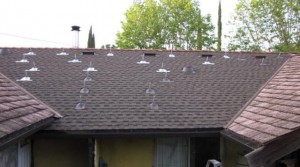 5/7/2010: REC sends out their guys to install the roof mounts.? I had previously requested extra tall “standoffs” be used.?? I wanted these for 2 reasons:? 1)? For clearance above the eyebrow vents.? 2)? For extra air movement below the modules (which lose performance as they get hotter).
5/7/2010: REC sends out their guys to install the roof mounts.? I had previously requested extra tall “standoffs” be used.?? I wanted these for 2 reasons:? 1)? For clearance above the eyebrow vents.? 2)? For extra air movement below the modules (which lose performance as they get hotter).
While they were here, the REC guys took new shade measurement pics and everything looks good… except the big ol’ chimney.?? I’m still bothered that the chimney is casting such a significant shadow on a couple of panels in the early morning.?? I draw up my own plan for module placement and send it to the engineers.? Basically I moved one panel up to the top row and shifted parts of the array to the West (away from the chimney).? Turns out that one of the big factors for the way they layout the array is symmetry.?? I said, “Hey, these are on the back side of the house so I’m not really worried about them being symmetrical.”? The engineers said, “No problem, we’ll go with your layout.”?? Guess what… this change was expected to net me an extra couple percent increase in output!
At the end of the day the Roof Right team comes out and completes their roof work and flashes in the roof mounts and even install my tubular skylight flashing for me!? I think it all looks absolutely fantastic!?? Click the picture to the right and you’ll see the new roof compared to the crumbly Terrashake / Cal-Shake roofing.
5/11/2010: We were hoping to begin the install today, but REC ran into some problems with TIGO and their supply of the management units that attach to each module.? I’m told there could be up to a 2-3 week delay before we can install the modules. ? While I’m a little bummed, I realize that we’re way ahead of the 14 week schedule I was originally expecting. ? I start thinking that either the 13 week schedule was a case of “under promise, over deliver” or that somehow things just went way faster than they expected?
5/18/2010: I get some great news about 6 days later that the units are in and we’re ready to go!? The team comes out and begins installing the rails and getting everything ready for the inverter and tie-in to the main electrical service box.
5/19/2010: The team comes back and installs 17 of the 18 modules (the one on the bottom of the stack shattered during travel).? The inverter and most of the electrical is installed!
They look absolutely fantastic and I’m super excited!
5/21/2010: The team comes back out and installs the last module and finishes a few other items.
This is where things get a bit sticky:? While working to tie into the main service box we found that there were some electrical problems that had the potential to be a huge problem (and expense).?? We were looking at having to replace and relocate the main service.? This would also require that the main line coming into the house to be moved and more roof work.? We’re talking potentially $5,000+ more work, permits and months of delays!!!!? Well, long story short, after 2 weeks working with 3 electricians and scouring the world for a few specific old parts and a TON of extra time and work from an amazing guy at REC, we were able to get the problem solved for under $200!? I seriously dodged a bullet!
6/7/2010: The city inspector comes by and meets with the rep from REC and walks the grounds.? I’m terribly nervous and am crossing my fingers that there aren’t any problems.?? After only about 15 minutes the inspector is gone and I get the great news:? We Passed! ? WOOT!
6/7/2010: All the paperwork is then submitted to PG&E for them to do the interconnection.? Even though my system is 100% ready to go, we need to get their stamp of approval to pull the switch.?? PG&E has up to 30 days to do their inspection and the interconnection.? Rumor has it that they are taking up to 3 weeks to get out to do the interconnection.?? UGH… it feels like “HURRY UP and wait.”
6/16/2010: It’s 9:50 AM and I’m loading the kids in the car for their very first day of swim lessons.?? As we’re about to pull out of the driveway I see a PG&E truck driving up the street.?? Can this be it?!?!? I send my wife off with the kids so I can stick around.??? The truck parks in front of the house and out comes a guy with a new bi-directional meter in his hand… I swear he looked just like Santa Claus!? Within 15 minutes he had pulled the old meter, installed the new one, and gave me the A-OK to pull the switch.? WOOOT!!? 9 Days? ? I think this is a new record for PG&E interconnection!
Right after he was gone I turned on the power.? After what seemed like FOREVER the inverter kicked on and I was live!? The new bi-directional meter started at 00000.?? I sat there and watched it until I saw it roll back to 99999.? 🙂
Summing up:? from contract signing to full interconnection was 76 days (almost 11 weeks) which put us about 1 month ahead of schedule… and that’s with the extra 2-3 weeks of problems related to the electric service issue.
You can click the image below for a high resolution picture of the final installation.? Also I’m including an image of the TIGO interface to show the cool visibility I have into the performance of each solar panel.
We’re using about 20-24 kilowatt hours per day and generating about 25.? At the time of writing this our meter says 99954 and has been as low as 99946.?? We didn’t build the system to completely offset our usage, but that’s just what happens during ideal conditions during the summer months.?? Our “credit” will carry forward month to month.? As the days get shorter we’ll be producing less than we use, and over the course of the year the credits that we’ve banked up over the summer will be used up.? We don’t expect that we’ll ever produce more in a year than we’ll use unless we totally change our habits… and with our daughters getting older I doubt that’s going to happen.
Hopefully you found this information helpful.?? If you’re interested in solar you should contact REC Solar and tell them Rob Ludlow sent you! Even if you’re not in the California San Francisco Bay Area, they may be servicing your area or have partners that do!
Any questions, simply comment below.
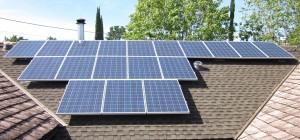
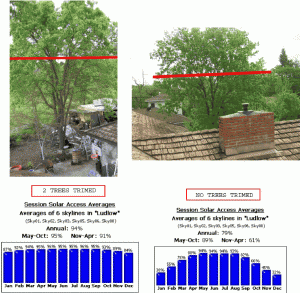
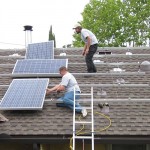
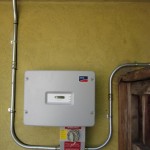
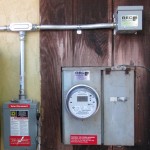
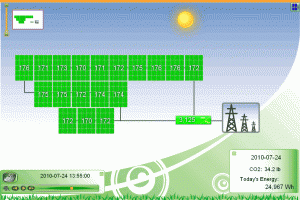
How did you get PG&E out so fast. I am 2 weeks and waiting.
Honestly, I think I just got lucky. When I asked the tech he said he was in the area and saw that I was on his list, and close, so he came by.
I’ve heard some horror stories about interconnection taking the whole 30 days which would have really put me in a sour mood!
We went down this path too and got bids that were 50,000 to 80,000! We were severely disappointed to get such high numbers! What did each panel cost at Costco?? At those prices we were still told we would only be replacing about 1/3 of our usage. Is it an east coast west coast thing??
Hi Sharon. I think the modules from Costco were about $650 each. I was just there a couple days ago and saw that they cary a “grape solar 220 watt solar panel” for $600.
Of course, this is the price without all the incentive, rebates, credits, etc. We saved quite a bit on our solar by taking advantage of these savings.
Regarding replacing usage: The goal is usually only to take you out of the higher / top tiers of the cost, so it may not make sense for you to offset more than 1/3 of your usage. We’ve been producing about 110% of our daily usage, but as the days get shorter this number goes down and down. I doubt we’ll be producing more than 40% of our daily usage during Winter, but that will still take us out of the high tiered rates.
Congrats on a nice install.
How do you like the Tigo components? Are they popular on the left coast?
What is the Tigo fee structure? I’ve only seen an old 2nd hand report that it was 6 months free, then 350 for 5 years.
I’m loving the Tigo system! In fact, I can’t imagine having a solar array without being able to monitor what’s going on and seeing how each panel is performing. This is even independent of the increase in efficiency I’m getting by having each module optimized.
I don’t know that Tigo is very popular (yet), but there is definitely a move toward systems that provide monitoring and individual panel management… this is one of the reasons that people choose “micro inverter” based systems.
Tigo fee structure probably varies with each company, but my deal is basically:
1) Additional cost for the Tigo modules on each panel (included in the total cost of the system, but I believe can be around $0.30 per watt).
2) Monitoring: My system has 60 months (5 years) included with the initial install and then the option to continue for around $300 for an additional 5 years. The Tigo system will still work without the monitoring, it just gives you extra visibility that I love.
PG&E received our application for interconnection on September 16. They are crying that they have way more applications than they used to and it is taking 6 weeks to process! They said we would not see an approval until early NOVEMBER.
PG&E knows about the CSI rebate, the federal tax credit, and the Sonoma County Energy Independence Program, which makes it easier to get a loan for energy saving improvements. It seems like every solar company west of the Rockies has been offering to give us an estimate, so how could PG&E not know that they would be getting more applications? It is a management decision to not allocate money for hiring and training more people to process those applications. More money for PG&E and less for the consumer.
I just found out this morning that legally, they have 30 days. I put in a complaint to the CPUC.
It seems to me that PG&E can only benefit by delaying. We keep paying for electricity even though we have paid for a $20,000 system. I hope there is some penalty PG&E has to pay for their delay.
Hey Homie!
Glad to see you went with solar. I think I told you I worked for SunPower Corp (huge Solar panel manufacturer and install place) a while back…
What a great price you got on install…
I’m moving to Valley springs I think. In Escrow at the moment for 11 acres… Gonna be checking out your chicken coup stuff! 🙂
Well said, but everyone needs to realize that adding Solar in their home is an asset that could improve the future worth of their home if / when they decide to sell. With the environment the way it is going we are not able to dismiss any product that provides no cost energy at no cost to both the shopper and more notably the earth!
Hi,
Sorry for my bad english.
So, after all this time, can you provide an opinion about problems, winter perfomance and overall satisfaction ?
Its just curiosity, because here in Brazil, we dont have nothing like your solar panels and hardware.
To be truly, we dont have any incentive to use solar energy.
Thanks.
We’re looking at getting solar panels with SunRun through Costco, live in the Bay Area. Looks like it’s been 6 years since yours were installed – any feedback on what you appreciate, what you would change, etc? I am sure technology has improved since 6 years ago, any further thoughts on panel type, size, inverter vs battery storage, etc.
THANKS for any help on this.
Hi John & Kathy, thanks for the comment!
I’m still very happy about my choices and there’s not a lot I’d want to change. The only thing I think I would have done differently is maybe go with an even bigger system in anticipation of my daughters getting older and using even more electricity… maybe even an electric car in the future. This would have also required a bigger inverter since the one we have is pretty much at capacity.
I don’t think I’d do battery storage, but as options like the Tesla Power-Wall become more prevalent and price competitive, I might look into something like that!